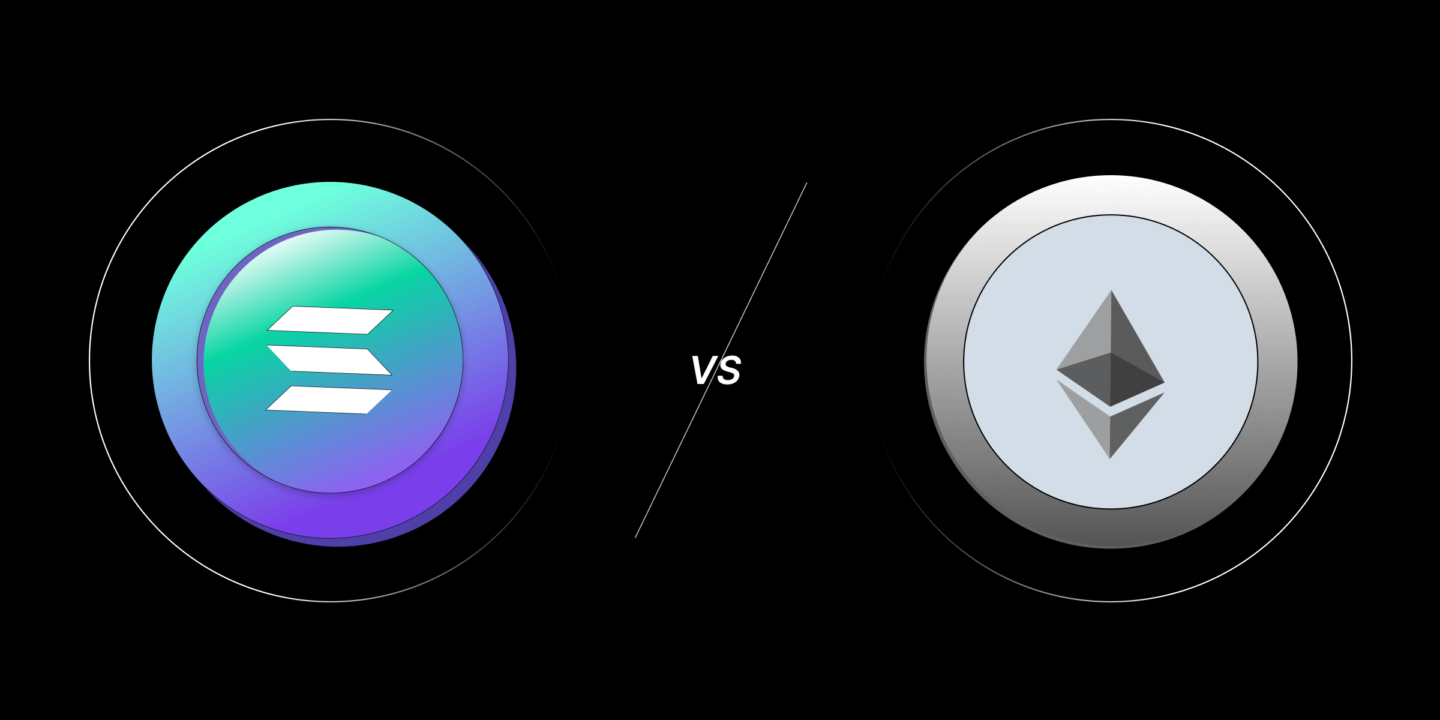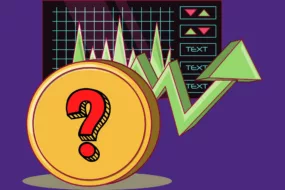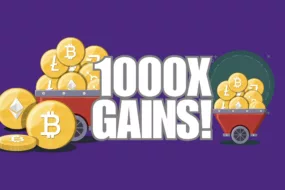
Solana and Ethereum are two blockchains capturing the spotlight in the crypto market due to their advanced technology, scalability, and potential to capture the decentralized finance (DeFi) market.
By understanding the differences that Solana and Ethereum offer regarding technology and security, you will be able to make smart investment decisions in the crypto world. In this blog, we will look closely at how these two are different and help you determine which suits you better.
Key Takeaways
- Performance Advantage:
- Solana boasts significantly higher transaction speeds, around 50,000 TPS, compared to Ethereum’s 15-45 TPS, due to its innovative consensus mechanisms.
- Solana’s speed advantage makes it ideal for applications requiring quick transaction confirmations, such as decentralized finance (DeFi) and gaming.
- Fee Structure:
- Solana offers extremely low transaction fees, often measured in fractions of a cent, making it suitable for micropayments and high-volume projects.
- In contrast, Ethereum’s gas fees can be significantly higher and fluctuate based on network congestion, potentially posing a barrier to entry for smaller transactions.
- Security and Decentralization:
- Ethereum has a longer track record and larger validator network, providing a greater sense of established security and decentralization compared to Solana.
- Solana, being relatively newer, is still establishing its long-term security and resilience, with past network outages raising concerns among investors.
- Developer Ecosystem:
- Ethereum boasts the largest developer community and a vast range of existing decentralized applications (dApps) across various sectors like DeFi, NFTs, and gaming.
- While Solana’s developer ecosystem is growing rapidly, it currently offers limited dApp selection compared to Ethereum, primarily due to its newer status in the blockchain space.
What is Solana?
- Fundamental Tech: Solana is a high-performance blockchain designed for speed and scalability. It achieves this through innovative technologies like Proof of History (PoH) and Proof of Stake (PoS).
- Origin Story: Solana was founded in 2017 by Anatoly Yakovenko. Its core goal is to solve the bottleneck of transaction speeds slowing down other blockchains.
- Goals: Solana aims to build a platform that can handle thousands of transactions per second without sacrificing low fees or decentralization. This makes it a promising choice for decentralized applications that need to be both fast and affordable.
Solana Latest Updates
- April 7, 2024: Solana’s price might rise despite current negative sentiment due to a potential market reversal, with a price chart showing a current value of $179.38 and a need to surpass $180 to reach $200 next.
- January 17, 2024: Solana’s network activity sees an upside for SOL tokens, with various developments like Dymension Airdrop, Unibot’s record use on Solana, and DeFi advancements.
- March 1, 2024: Bitcoin trades above $62,000 for the first time since November 2021, with Solana experiencing positive trends alongside other cryptocurrencies like Dogecoin.
What is Ethereum?
- Fundamental Tech: Ethereum is a programmable blockchain platform. Think of it as a giant decentralized computer that supports smart contracts (self-executing contracts) and decentralized applications (dApps).
- Origin Story: Vitalik Buterin proposed Ethereum in 2013, and it has grown into one of the most influential blockchain projects in the world.
- Goals: Ethereum aims to create a decentralized platform for building unstoppable applications that are transparent, secure, and resistant to censorship.
READ NOW: Ethereum Price Prediction
Ethereum/ETH Latest Updates
- April 6, 2024: Ethereum’s price might retest $3,250 before reaching $4,000 again, as pre-halving dips are common.
- April 5, 2024: Ethereum Layer 2 networks are predicted to be valued at over $1 trillion by 2030, with VanECK expecting a surge in value due to their scalability and efficiency.
- March 13, 2024: Ethereum’s network undergoes a major upgrade, Dencun, which lowers transaction fees on the network.
Learn more about Ethereum HERE.
Solana vs Ethereum: Head-to-Head Comparison
Let’s break down the key differences between Solana and Ethereum. This head-to-head comparison will examine their performance, fees, security, and potential use cases, helping you understand which blockchain might better suit your needs.
| Feature | Solana | Ethereum |
| Consensus Mechanism | PoH (Proof of History) + PoS (Proof of Stake) | PoW (currently) -> Transitioning to PoS (Ethereum 2.0) |
| Transaction Speed (TPS) | ~50,000 TPS (extremely fast) | ~15-45 TPS (slower, scalability issues) |
| Transaction Fees | Fractions of a cent (very low) | Variable gas prices (can be high, depends on network load) |
| Security and Decentralization | Newer focus on security improvements | Established, battle-tested, larger validator network |
| Smart Contracts & Developer Ecosystem | Growing ecosystem, popular for speed/low fees (Rust, Solana VM) | Largest developer community, vast dApps (Solidity, EVM) |
| Native Token (Tokenomics & Staking) | SOL ( ~5.7% APY staking) | ETH (~4.0% APY staking) |
1. Consensus Mechanism
Solana uses Proof of History (PoH) and Proof of Stake (PoS). PoH creates a verifiable record of time, allowing for faster transaction confirmation. PoS reduces energy consumption compared to Proof of Work (PoW) used by Ethereum (currently). This translates to faster finality for users on Solana, with transactions being settled near-instantly.
Ethereum is transitioning to PoS (Ethereum 2.0) to address scalability issues and improve efficiency. However, Ethereum’s PoW mechanism can lead to slower transaction confirmation and higher fees during peak usage times.
Impact
- Solana’s faster confirmation times and lower fees might be more attractive for everyday use.
- Ethereum’s established ecosystem might be more appealing for long-term investments in DeFi projects or established applications.
2. Transaction Speed (TPS)
Solana boasts a remarkably high transaction speed, clocking in at around 50,000 TPS. This rapid processing power puts Solana much ahead of Ethereum (Ethereum’s current speed is approximately 15-45 TPS)
To put this in perspective, even Bitcoin, the world’s largest cryptocurrency by market capitalization, processes transactions at a snail’s pace of around seven transactions per second. That’s about x2 slower than Ethereum and a whopping x7,000 slower than Solana!
The difference in transaction speed is due, in large part, to the underlying consensus mechanisms employed by each blockchain. Solana’s efficient Proof of History (PoH) and Proof of Stake (PoS) combination streamlines transaction verification, resulting in near-instantaneous confirmation times.
Impact
- Solana feels instant, which is ideal for quick actions. Ethereum might lag during peak use.
- Solana’s higher TPS means the network can support more users and applications without slowing down. This is crucial for the growth of decentralized apps, especially in areas like DeFi or gaming.
3. Transaction Fees
Transaction fees, also known as “gas fees” on Ethereum, are the costs associated with processing a transaction on a blockchain. Here’s how Solana and Ethereum differ:
- Solana: Solana boasts incredibly low transaction fees, typically measured in fractions of a cent. This makes it ideal for micropayments or applications where even small fees can be a barrier to entry.
- Ethereum: Ethereum’s gas fees are significantly higher and can fluctuate based on network congestion. During peak usage times, these fees can surge to several dollars or even tens of dollars per transaction, making it impractical for everyday use cases like buying NFTs or sending small amounts of cryptocurrency.
The difference in fees stems from the underlying technologies. Solana’s efficient consensus mechanism and innovative architecture allow it to process transactions at a much lower cost. Conversely, Ethereum’s Proof-of-Work (PoW) system requires more computational power, driving up the cost of validating transactions.
Impact
- Solana: Lower fees for high-volume projects, potentially boosting profitability.
- Ethereum: An established network might outweigh the high fees for some projects.
4. Security and Decentralization
Solana is a relatively newer blockchain that focuses on innovative security measures. It has experienced some network outages in the past, raising questions about the platform’s long-term security and highlighting the need for continuous stress testing. It employs Proof of Stake (PoS), where validators stake tokens for the right to validate transactions, which helps ensure honesty within the network.
Ethereum boasts a longer track record and is often considered a more battle-tested chain due to its early launch and large number of users. It has a more decentralized network, with thousands of validators securing the blockchain. However, Ethereum’s past issues with congestion and scaling highlight the ongoing challenge of balancing decentralization with transaction speeds.
Impact
- Solana is still establishing its long-term security and resilience in the face of potential attacks, which could be a concern for investors prioritizing security above all else.
- Ethereum provides a greater sense of established security and decentralization, making it a possible safer bet for projects with those core values.
5. Smart Contracts & Developer Ecosystem
Smart contracts are the building blocks of decentralized applications (dApps), and a robust developer ecosystem is crucial for a blockchain’s growth.
Solana’s developer ecosystem is rapidly expanding, attracting projects drawn to its high speed and low transaction fees. Developers primarily use the Rust programming language for Solana smart contracts. The Solana Virtual Machine (SVM) provides the environment for running these contracts.
Ethereum has the largest developer community and a massive range of existing decentralized applications (dApps) across various sectors like DeFi, NFTs, and gaming. Solidity is the primary programming language for Ethereum smart contracts executed on the Ethereum Virtual Machine (EVM).
Impact
- Solana is a Growing ecosystem with potential opportunities for new projects to stand out. However, compared to Ethereum, there is limited dApp selection.
- Ethereum has a Larger pool of existing dApps and developer resources. However, the network can get congested during heavy use, impacting speed and fees.
6. Native Token (Tokenomics & Staking)
Each blockchain has its native cryptocurrency, which plays a crucial role in the ecosystem’s functionality and economic incentives.
Solana’s native token, SOL, is used to pay transaction fees and participate in staking. Staking SOL helps secure the network and provides validators with rewards. SOL has experienced significant price appreciation in recent years, reflecting market optimism about Solana’s potential.
Ethereum’s native token, ETH, is used to pay gas fees and is transitioning to a staking model with Ethereum 2.0. Staking ETH also contributes to network security and earns rewards. ETH’s long track record and central role in the broader crypto ecosystem give it a degree of stability but also make price growth less erratic than some newer tokens.
Impact
- Right now, SOL Offers the potential for higher staking rewards and potentially greater price volatility, which could be attractive to high-risk investors.
- Ethereum (ETH): While expected staking rewards are slightly lower (currently around 4% APY), ETH’s established position in the market could provide a sense of greater stability, especially for longer-term investments.
Solana vs Ethereum: Use Cases
Solana and Ethereum’s unique strengths make them appealing for different use cases. Here’s a breakdown across some key areas:
1. NFTs
- Solana: Fast speeds and low fees make Solana enticing for minting NFTs. Popular marketplaces like Magic Eden have emerged. Collectors enjoy quick transactions and low fees, which are perfect for high-volume NFT trades or buying affordable micro-assets.
- Ethereum: Despite high gas fees, Ethereum boasts the largest NFT ecosystem and established marketplaces like OpenSea and Rarible. This attracts collectors seeking access to rare and blue-chip NFT collections. Ethereum’s established position can give a sense of security and longevity for creators building long-term projects.
2. DeFi (Decentralized Finance)
- Solana: Speed and affordability are game-changers for DeFi projects. Apps like Serum (a decentralized exchange) offer lightning-fast trades and minuscule fees, making complex DeFi strategies more accessible.
- Ethereum: The pioneer in DeFi, Ethereum still houses the majority of DeFi protocols with massive amounts of value locked. Projects like Uniswap, Compound, and Aave continue to innovate, even as fees can be a hurdle for smaller users.
3. Potential Future Use Cases
- Both chains could power metaverse applications, depending on the project’s needs.
- Gaming: Solana’s low cost and high throughput make it promising for blockchain-based games, especially those needing fast, low-cost interactions (think in-game economies). Ethereum’s large community could still attract games prioritizing reach and network effects.
- Metaverse: Both blockchains could power metaverse applications depending on the needs of the project. While Solana’s edge might be in fast-paced or graphically intensive experiences, Ethereum’s community could be ideal if the social component is key.
Solana vs Ethereum: Final Verdict
Ethereum is sometimes labeled as the “Solana Killer.” But let’s remember that blockchain technology is constantly evolving.
Solana’s current speed and affordability offer undeniable advantages. However, it’s important to acknowledge challenges like past network outages, which highlight the ongoing need for improvement.
Ethereum’s upgrades aim to close the performance gap, potentially offering a blend of speed and its established ecosystem. Additionally, competitors like Cardano and Polygon present compelling alternatives, further diversifying the blockchain landscape. This could lead to a future where multiple chains thrive, each catering to specific use cases.
Ultimately, Solana’s success hinges on its ability to innovate, continuously bolster its security, and address centralization concerns. If it tackles these challenges, Solana has the potential to remain a major force in the crypto world and a valuable tool for developers and users alike.
Solana vs. Ethereum: Which Should I Invest In?
Choosing between Solana and Ethereum for investment depends entirely on your individual goals and risk tolerance.
Solana’s focus on speed and affordability could lead to more rapid growth potential, especially if it continues to attract new projects and users. This potential comes with higher risk, as the network is still relatively new.
Ethereum boasts a more established position with a large, active ecosystem. While it faces scalability challenges, the transition to Ethereum 2.0 aims to address these issues. This offers potential stability, but growth may be less explosive than Solana’s.
Before investing, do thorough research on both projects, their roadmaps, tokenomics, and current market trends. Diversifying your portfolio with a mix of both could be a strategy to consider.
Conclusion
Solana and Ethereum are both strong players in the crypto world. If you want lightning-fast transactions and tiny fees, Solana might be the way to go. If you prefer a large, established network with tons of apps, Ethereum could be a better fit. Feeling overwhelmed? Mudrex is here to help! With simple explanations, expert insights, and guides, Mudrex makes it easy for you to explore both of these options.
Our expertly curated coinsets offer convenient exposure to a wide range of cryptocurrencies, including Ethereum and Solana. Whether you’re a seasoned investor or just venturing into the crypto space, Mudrex simplifies the process, allowing you to invest strategically in the future of blockchain technology. Download the Mudrex App now and start investing in a diverse range of coins.
FAQs
1. Is Solana a better investment than Ethereum?
There’s no simple answer. Both SOL and ETH have distinct strengths and weaknesses and carry potential. Ethereum benefits from an established ecosystem and a larger market cap. Solana focuses on speed and lower fees. The best investment for you depends on your risk tolerance and your belief in each project’s long-term prospects. Thorough research is essential before making any investment decisions.
2. Is Solana the next Ethereum?
While Solana has the nickname “Ethereum Killer,” it’s unlikely to fully replace Ethereum. Solana offers advantages in speed and transaction costs, appealing to certain projects. However, Ethereum’s lead in adoption, its established developer community, and the upcoming transition to Proof of Stake offer strong reasons for its continued dominance.
3. Will SOL overtake ETH?
It’s possible but highly uncertain. The cryptocurrency market is dynamic. If Solana continues to solve scalability challenges and attracts significant developers and projects, it could gain market share. However, Ethereum’s updates and strong developer base make it a tough competitor.
4. Who will replace Solana?
The blockchain space is highly competitive. Newer projects always try to overcome the limitations of existing ones. Some potential future competitors to Solana could emerge from other Layer 1 chains focusing on efficiency and scalability. Stay updated on the latest blockchain developments to watch for potential rivals.
5. Can SOL reach $1000?
Cryptocurrency prices are highly speculative. While SOL might reach that mark, it’s dependent on many factors, such as overall market adoption, Solana’s technical advancements, and competition. Predicting crypto prices with certainty is impossible.
6. Will Solana be as big as ETH?
Solana has a rapidly growing ecosystem, but reaching Ethereum’s scale is a huge challenge. Ethereum’s first-mover advantage and the breadth of projects built on it give it a substantial head start. Solana will need to demonstrate sustained innovation and attract major dApp development to rival Ethereum’s size.





